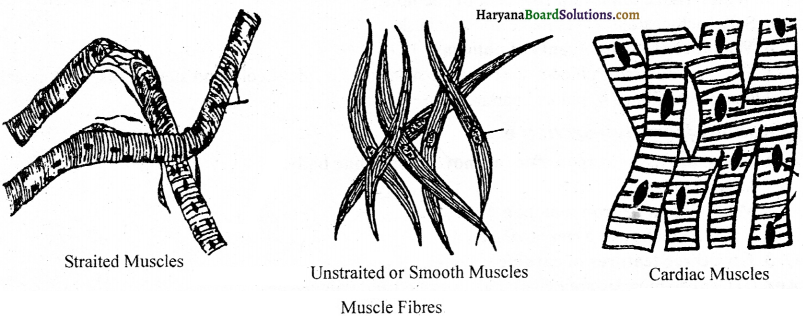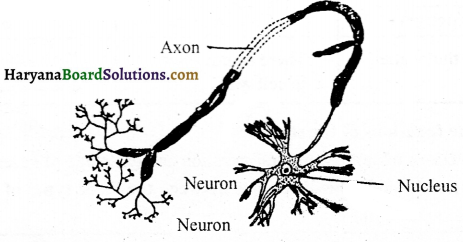Haryana State Board HBSE 9th Class Science Solutions Chapter 6 Tissues Textbook Exercise Questions and Answers.
Haryana Board 9th Class Science Solutions Chapter 6 Tissues
HBSE 9th Class Science Tissues Intext Questions and Answers
Questions from Sub-section 6.1
Question 1.
What is a tissue?
Answer:
A tissue is a group of similar cells that performs similar function.
Question 2.
What is the utility of tissues in multicellular organisms ?
Answer:
They help in efficient working of the body of such organisms.
Questions from Sub-section 6.2.2 (i)
Question 1.
Which gas is needed for photosynthesis?
Answer:
Carbon dioxide.
Question 2.
State the role of transpiration in plants.
Answer:
In plants the role of transpiration is performed by leaves. There are many minute pores in the leaves of every plant. These pores are called stomata. There are guard cells on stomata which carry out the exchange of gases. These guard cells transpirate the water obtained from the earth.
![]()
Questions from Sub-section 6.2.2 (ii)
Question 1.
Name types of simple tissues.
Answer:
Simple tissues are of three types:
(1) Parenchyma
(2) Collenchyma
(3) Sclerenchyma.
Question 2.
Where is apical meristem found?
Answer:
It is located at the root and shoots tips.
Question 3.
Which tissue makes up the husk of coconut?
Answer:
Sclerenchymatous fibers make coconut husk.
Question 4.
What are the constituents of phloem?
Answer:
The constituents of phloem are:
1. sieve elements i. e., sieve cells, and sieve tubes
2. companion cells
3. phloem (bast) fibers
4. phloem parenchyma.
Questions from Sub-section 6.3.4
Question 1.
Name the tissue responsible for movement in our body.
Answer:
Muscular tissue.
Question 2.
What does a neuron look like?
Answer:
A neuron looks like a star having a tail.
![]()
Question 3.
Give three features of cardiac muscles.
Answer:
(i) Cardiac muscles are cylindrical, branched, and uninucleate.
(ii) They show faint cross striations.
(in) They are joined end to end by intercalated discs.
Question 4.
What are the functions of areolar tissue?
Answer:
(i) It binds muscles with skin.
(ii) It provides support to internal organs
(iii) It helps in repair of tissues.
HBSE 9th Class Science Tissues Textbook Questions and Answers
Question 1.
Define the term ‘tissue’.
Answer:
Tissue is a group of cells having a common origin, similar in structure and function.
Question 2.
How many types of elements together make up the xylem tissue?
Answer:
Four types of elements present in xylem are:
Tracheids, vessels, xylem fibres and xylem parenchyma.
Question 3.
How are simple tissues different from complex tissues in the tissue? Name them.
Answer:
Simple plant tissues are made up of only one type of cells, e.g. parenchyma, whereas complex tissues are made up of many types of cells, e.g. xylem.
Question 4.
Differentiate between parenchyma, collenchyma and sclerenchyma on the basis of their cell wall.
Answer:
Parenchyma:
Cells are thin walled.
![]()
Collenchyma:
There is movement in cell wall.
Scierenchyma:
Cell walls are highly thickened due to lignin deposition.
Question 5.
What are the functions of the stomata?
Answer:
The main functions of stomata are transpiration and the exchange of gases.
Question 6.
Diagrammatically show the difference between the three types of muscle fibres.
Answer:
Three types of muscle fibres:
Straited muscle:
1. These are elongated, cylindrical, unbranched and multinucleate
2. These are voluntary.
3. These are attached to bones.
Untreated muscle:
1. These are spindle-shaped and uninucleate.
2. These are involuntary
3. These are found in eyelit, and lungs.
Cardiac muscle:
1. These are cylindrical branched and uninucleate.
2. These are involuntary.
3. These are found in cardiac walls.

Question 7.
What is the specific function of the cardiac muscle?
Answer:
They undergo rhythmic contraction and relaxation throughout life. They never get fatigued.
![]()
Question 8.
Differentiate between striated, unstriated, and cardiac muscles on the basis of their structure and site/location in the body.
Answer:
| Cause of difference | Straited muscle | Unstraited muscle | Cardiac muscle |
| Site | These muscles work accordingly to our will. | These muscles do not work according to our will. | These muscles do their work themselves. |
| Location | They are attached to skeleton. | They are found in the walls of the organs of the body | They are found in the walls of heart. |
Question 9.
Draw a labeled diagram of a neuron.
Answer:
Diagram of a neuron:

Question 10.
Name the following:
(a) Tissue that forms the inner lining of our mouth.
(b) Tissue that connects muscle to bone in humans
(c) Tissue that transports food in plants.
(d) Tissue that stores fat in our body.
(e) Connective tissue with a fluid matrix.
(f) Tissue present in the brain.
Answer:
(a) Epithelial tissue (squamous epithelium).
(b) Tendon (a type of connective tissue).
(c) Sieve elements (phloem).
(d) Adipose tissue (a type of connective tissue).
(e) Vascular tissue (blood).
(f) Nervous tissue.
![]()
Question 11.
Identify the type of tissue in the following:
Skin, bark of tree, bone, lining of kidney tubule, vascular bundle.
Answer:
Skin: Epithelial tissue.
Bark of tree: Cork.
Bone: Connective tissue.
Lining of kidney tubule: Epithelial tissue (cubodial epithelium).
Vascular bundle: Sclerenchyma.
Question 12.
Name the regions in which parenchyma tissue is present.
Answer:
Parenchyma is present in stem, root, leaves, flowers and fruits. It is the most common plant tissue.
Question 13.
What is the role of epidermis in plants ?
Answer:
It protects the parts of the plant. It helps in protections against excessive water loss. It helps the plant parts from mechanical injuries and attack of parasites (fungi, bacteria etc.).
Question 14.
How does the cork act as protective tissue ?
Answer:
Cork cells are highly thick walled, dead and protective in nature. They have deposition of suberin. They check water loss and prevent the entry of harmful microbes into plant body.
Question 15.
Complete the table:

Answer:
